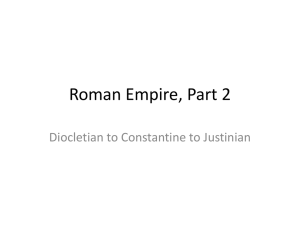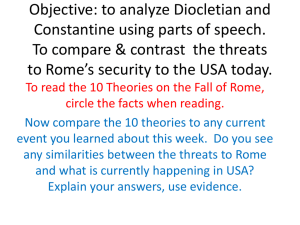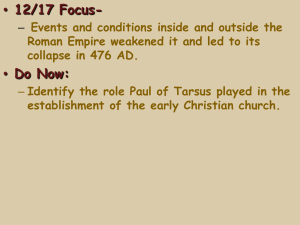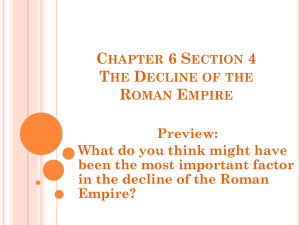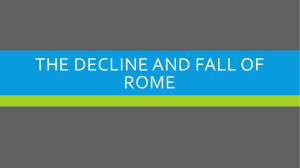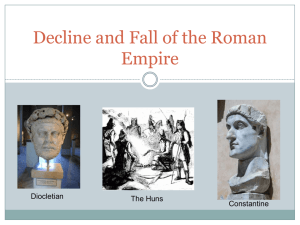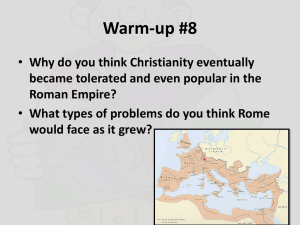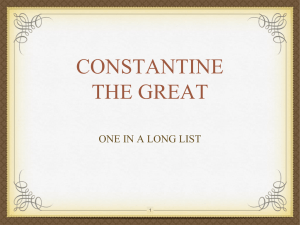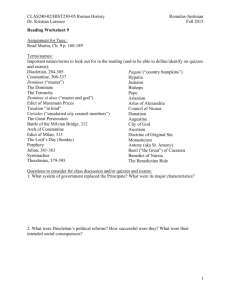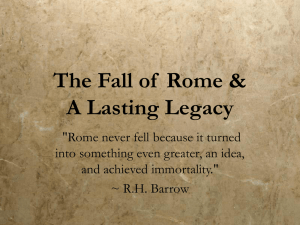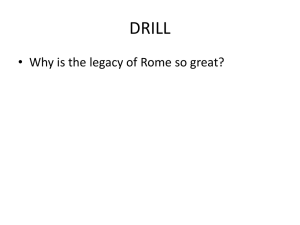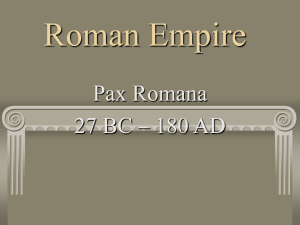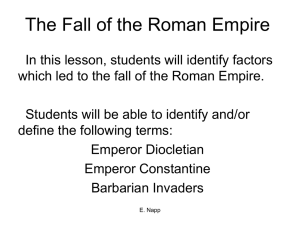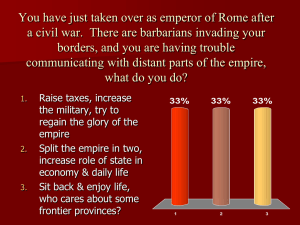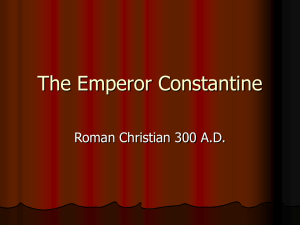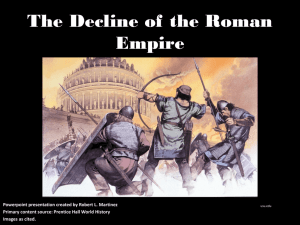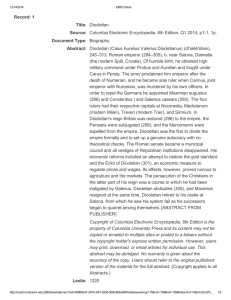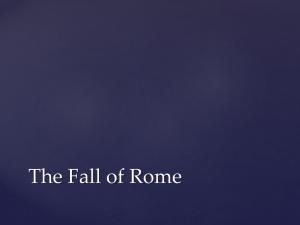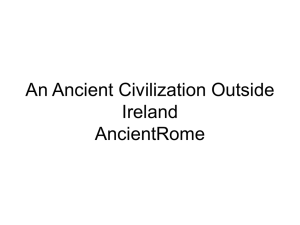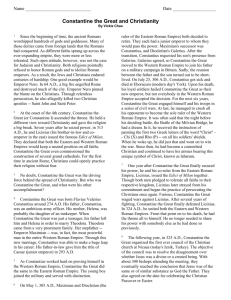slides
advertisement
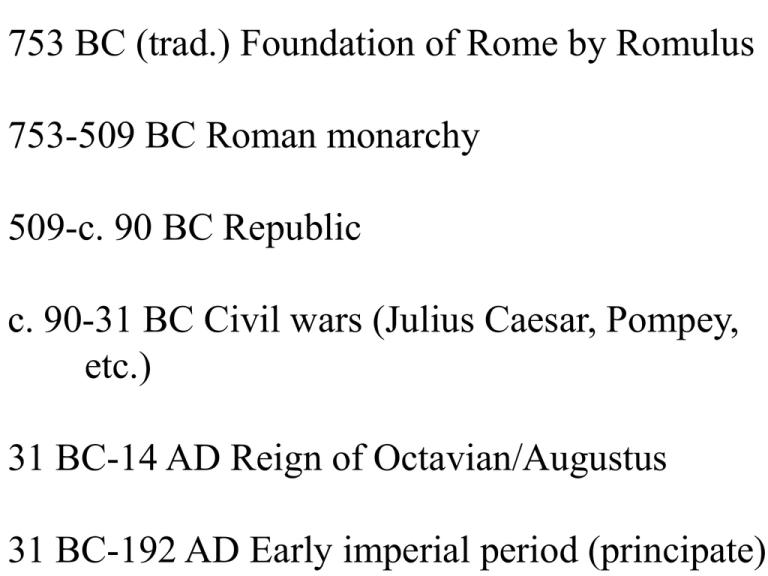
753 BC (trad.) Foundation of Rome by Romulus 753-509 BC Roman monarchy 509-c. 90 BC Republic c. 90-31 BC Civil wars (Julius Caesar, Pompey, etc.) 31 BC-14 AD Reign of Octavian/Augustus 31 BC-192 AD Early imperial period (principate) Map Link: Territorial Expansion of Rome: <https://www.lib.utexas.edu/maps/historical/shepherd_1911/ shepherd-c-034-035.jpg> Problems in the Roman Empire End of imperial expansion: loss of income, prestige, etc. Increasing influence of non-Italians in society, government, the army Increasing attacks on borders Increasingly centralised government Increased militarisation of state 235 Army murders Severus Alexander (r. 222-235) 235-84 Period of crisis: civil and external wars, plague, economic crisis, raised taxes 259 Persians defeat Roman army and capture Valerian (r. 253-60) Diocletian (r. 284-305) Constantine (r. 306-37) Map Link: Map of the Tetrarchy: <http://neobyzantium.com/wp-content/uploads/2009/12/ Roman-Empire-during-the-1st-Tetrarchy.jpg> Diocletian’s Reforms Multiple capitals: closer links between local governments and imperial government, so swifter responses Reforms of army: imperial bodyguards, mobile army and border defence forces. Soldiers no longer in civil administration Reforms of coinage, pricing, state building projects, annona (universal land tax) Diocletian’s Reforms Improving loyalty by presenting self as earthly manifestation of Jupiter. Persecuting Christians Diocletian’s Reforms Augusti: Diocletian Maximian Caesars: Galerius Constantius Diocletian’s Reforms Retired 305: Diocletian Maximian Augusti: Galerius Constantius Caesars: Disputed 306 Constantine (son of Constantius) acclaimed by troops as emperor 312 Battle of Milvian Bridge. Constantine becomes an augustus (co-emperor) 313 Constantine makes Christianity official religion of the empire, though others tolerated 324 Constantine becomes sole emperor, establishes new capital at Byzantion (Constantinople): “Nova Roma Constantinopolitana” (New Rome, the City of Constantine) 332 Constantine repels Goths 337 Death of Constantine. Sons fight over succession 337-61 Reign of Constantius II 353 Constantius II reunites empire 356 Constantius bans public paganism 361-63 Reign of Julian (the Apostate) Problems of the Late 4th Century Divergence of Eastern and Western Empires Foreign involvement: Settlement of barbarians in east Valentinian II (r. 375-92), Western Roman Emperor, plus successor, puppets of Arbogast the Frank Brief reunification under Theodosius (r. 379-95) in 394, but does not last The End End 4th c. Accession of young emperors. Power held by regents, mostly from military or female relatives of emperors. Barbarians being bribed to fight each other 476 Last Western Roman Emperor, Romulus Augustulus (r. 475-76), deposed by Odoacer the Ostrogoth. End of Roman Empire in west. Eastern Roman Empire remains, from now usually called Byzantine Empire Ammianus Marcellinus (c. 325-392 or 395) Born in Antioch, Syria. Of Greek descent, probably noble Joined army in his twenties. Served until death of Julian the Apostate, whom admired Pagan, but not fervently anti-Christian After retired, travelled, then settled in Rome after 378 Ammianus Marcellinus (c. 325-392 or 395) Spent rest of life writing Res Gestae a Fine Corneli Taciti (or Rerum Gestarum Libri qui Supersunt), history of Rome continuing work of Tacitus (c. 55-117) and covering years 96-378 (ending with Battle of Adrianople) Uses mix of eyewitness experiences and written sources Salvian (Salvianus, c. 400-480) Born in Trier. Noble descent, raised Christian Married, but both he and wife entered monastery at Lerins c. 424 Ordained as priest. Renowned preacher and teacher of rhetoric Was priest in Marseilles by 430 Salvian (Salvianus, c. 400-480) Wrote several works. We have set of 9 letters and this work: De Gubernatione Dei Treatise on God’s guidance of history
